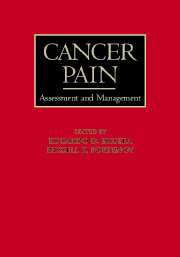Book contents
- Frontmatter
- Contents
- List of contributors
- Preface
- SECTION I MECHANISMS AND EPIDEMIOLOGY
- SECTION II ASSESSMENT AND SYNDROMES
- 4 The assessment of cancer pain
- 5 Multidimensional assessment: pain and palliative care
- 6 Cancer pain syndromes
- SECTION III PHARMACOLOGICAL TREATMENT
- SECTION IV NONPHARMACOLOGICAL APPROACHES
- SECTION V THE ROLE OF ANTINEOPLASTIC THERAPIES IN PAIN CONTROL
- SECTION VI PAIN IN SPECIAL POPULATIONS
- SECTION VII DIFFICULT PAIN PROBLEMS
- SECTION VIII SPECIAL TOPICS
- Index
6 - Cancer pain syndromes
from SECTION II - ASSESSMENT AND SYNDROMES
Published online by Cambridge University Press: 08 October 2009
- Frontmatter
- Contents
- List of contributors
- Preface
- SECTION I MECHANISMS AND EPIDEMIOLOGY
- SECTION II ASSESSMENT AND SYNDROMES
- 4 The assessment of cancer pain
- 5 Multidimensional assessment: pain and palliative care
- 6 Cancer pain syndromes
- SECTION III PHARMACOLOGICAL TREATMENT
- SECTION IV NONPHARMACOLOGICAL APPROACHES
- SECTION V THE ROLE OF ANTINEOPLASTIC THERAPIES IN PAIN CONTROL
- SECTION VI PAIN IN SPECIAL POPULATIONS
- SECTION VII DIFFICULT PAIN PROBLEMS
- SECTION VIII SPECIAL TOPICS
- Index
Summary
Introduction
Pain can undermine quality of life, leading to psychological distress and a decline in physical function and social interaction (1,2). Surveys have demonstrated that 30%–60% of cancer patients experience pain during active anticancer therapy and that this prevalence rises to more than two thirds among those with advanced disease (3). Uncontrollable pain is a major risk factor in cancer-related suicide (4–10).
Given the pervasiveness of acute and chronic pain in the cancer population and its propensity to cause psychological distress and decreased physical functioning, all treating health care professionals should become skilled in pain management (11–14). Unfortunately, cancer pain continues to be undertreated by clinicians (11,15). Among the reasons for this inadequate treatment is poor assessment (16,17). The problematic nature of poor assessment was highlighted in a study of the concordance of pain reports between patient and clinician; in 73% of cases, oncologists stated pain as less severe than did the patients themselves (16).
The first step in cancer pain assessment involves characterization of the pain complaint. This includes description of the pain syndrome and inferences about the pathophysiology of the pain. Second, it is imperative to properly evaluate the impact of pain on every aspect of the individual's functioning.
A description of pain intensity clarifies the urgency of relief and guides selection of medication, route of administration, and rate of dose titration (18). Assessment of pain intensity also may help elucidate the pain mechanism and underlying syndrome.
The quality of pain is used empirically to help infer pathophysiology. For instance, somatic nociceptive pain may be localized, sharp, aching, and/or throbbing with a pressure sensation.
- Type
- Chapter
- Information
- Cancer PainAssessment and Management, pp. 89 - 108Publisher: Cambridge University PressPrint publication year: 2003
- 9
- Cited by



